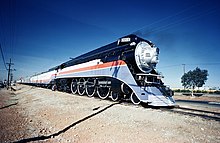Wikijunior:United States Charters of Freedom/Freedom Train

The United States has seen two Freedom Trains. The 1947–49 Freedom Train was a special exhibit train that toured the United States in the later half of the 1940s. A similar train called the American Freedom Train toured the country for the United States Bicentennial celebration in 1975–76. Both trains were painted in special red, white and blue paint schemes, and both toured the 48 contiguous states with displays of Americana and related historical artifacts. The two trains took different routes around the 48 states, but they both stopped for public displays in each of them.
The 1947-1949 Freedom Train[edit | edit source]
The 1947–1949 Freedom Train was proposed by Attorney General Tom C. Clark as a way to reawaken Americans to their taken-for-granted principles of liberty in the post-war years. The idea soon got the approval of President Harry S. Truman and everything else fell into place. Top Marines were selected to attend to the train and its famous documents. The Marine contingent was led by Col. Robert F. Scott.
The train carried the original versions of the Declaration of Independence, Constitution and the Bill of Rights on its tour of more than 300 cities in all 48 states. As Alaska and Hawaii didn't gain statehood until 1959, this train toured all of the US States that existed at the time.
The 127 documents carried by the train included a copy of the Magna Carta, the Emancipation Proclamation, the Gettysburg Address, the Iwo Jima flag, the German and Japanese surrender documents that ended World War II, and six historic flags.
The Freedom Train even had an official song, written by Irving Berlin and performed by Bing Crosby and the Andrews Sisters.
The train's first public display stop occurred in Philadelphia, Pennsylvania, on September 17, 1947. From there, the train traveled in a route that took it up to New England, down the Atlantic coast to Florida, across the nation's southern states to California, up the Pacific coast to Washington, then across the northern states to Minnesota. After touring the perimeter of the nation, the train moved inland from Minnesota to Colorado then Kansas and Missouri, north to Wisconsin, then south to the Ohio River valley, north again to Michigan and finally east to New Jersey. The train's official tour end occurred on January 22, 1949 in Washington, DC, nearly three months after its last public display October 26, 1948 in Havre de Grace, Maryland. It was the first train to visit all 48 contiguous states.
The 1975–1976 American Freedom Train[edit | edit source]
A second Freedom Train, The American Freedom Train, toured the country in 1975–1976 to commemorate the United States Bicentennial. This 26-car train was powered by three newly restored steam locomotives. The first to pull the train was former Reading Company 4-8-4 #2101. The second was former Southern Pacific 4449, a large 4-8-4 steam locomotive that is still operating in special excursion service today. The third was former Texas & Pacific 2-10-4 #610, which pulled the train in Texas.
Within the train's 10 display cars were over 500 precious treasures of Americana. Included in these diverse artifacts were George Washington's copy of the Constitution, the Louisiana Purchase, Judy Garland's dress from The Wizard of Oz, Joe Frazier's boxing trunks, Martin Luther King's pulpit and robes, and even a rock from the moon.
Over a 21 month period from April 1, 1975 to December 31, 1976 more than 7 million Americans visited the train during its tour of all 48 contiguous states. Millions more stood trackside to see it go by.
The train's tour began April 1, 1975, in Wilmington, Delaware. The train then traveled northeast to New England, west through Pennsylvania, Ohio to Michigan, then around Lake Michigan to Illinois and Wisconsin. From the Midwest, the tour continued westward, zigzagging across the plains to Utah and then up to the Pacific Northwest. From Seattle, Washington, the tour then traveled south along the Pacific coast to southern California. The train and crew spent Christmas 1975 in Pomona, California, decorating the locomotive with a large profile of Santa Claus on the front of the smokebox above the front coupler. For 1976, the tour continued from southern California eastward through Arizona, New Mexico and Texas, then turned north to visit Kansas and Missouri before traveling through the Gulf Coast states and then north again to Pennsylvania. The tour continued southeast to New Jersey then south along the Atlantic coast before finally ending December 26, 1976 in Miami, Florida. The last visitor went through the train December 31, 1976.
See also[edit | edit source]
Source[edit | edit source]
Basically a junior version of the Wikipedia article.